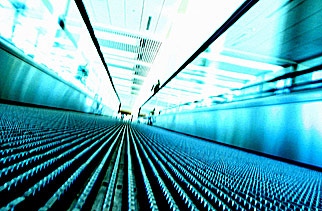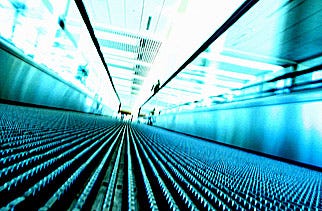New developments in packaging-line conveyor systems
March 11, 2015


Conveyor
Companies making consumer products today often achieve a competitive advantage through more appealing and easier-to-use package designs. As a result, products and packages are constantly changing as manufacturers race to gain and keep that advantage. How can a packaging operation keep up with constant changes without increasing costs?
Surprisingly, new choices in packaging conveyors can help companies create a more sustainable packaging system—with lower costs over the long term, the critical flexibility they need, and a healthy reduction in their overall energy footprint.
Framing choices make a difference
Most packaging conveyors today are modular by design, available in pre-configured straight or curved sections that bolt together. The structural conveyor frame is typically made of extruded, T-slotted aluminum, welded steel or, if the packaging environment requires it, stainless steel.
To build as much flexibility into their packaging operation as possible, many companies turn to conveyors with an extruded aluminum frame, whose T-slotted design lets them reconfigure the system virtually at will, adding to or repositioning the originally purchased equipment. These anodized aluminum frames don’t need welding or painting, so they install quickly. The available T-slots in the extruded aluminum frame also provide a convenient attachment point for other accessory equipment: Lights, vision systems, labeling devices, and more.
A welded steel frame is typically much more difficult to re-configure, which may mean that major upgrades or changes to the packaging process will require scrapping the original system altogether. While many packaging conveyors of this type may seem less expensive at the outset, the additional costs of frequent changeovers can lead to unexpected, unpleasant surprises.
If stainless steel is required for hygienic reasons, the better systems are designed to provide flexibility similar to that of aluminum systems, with slot-type openings along the conveyor rails, and similar bolt-together conveyor modules. By investing in conveyors that are able to adapt to constantly changing requirements, companies are already taking a positive step in reducing the total cost of ownership in their packaging conveyors.
Curve design
Sophisticated product routing is a frequent requirement in larger-scale packaging systems. As boxes, packets, bottles or other packaged products are transferred by a conveyor, they may need to be elevated or lowered, accumulated or repositioned, and transferred around tight or long-sweep curves. Fortunately, experienced conveyor suppliers offer a wide range of vertical and horizontal curves to put the product where it’s needed when it’s needed there. But here again, the right choices can lead to significantly lower costs over the long term.
Nearly all commonly used packaging conveyors transfer packages on a transport chain that slides along the conveyor frame on a slide rail of some type. For straight conveyor sections, the friction inherent to any given system will be a function of material choices and the use of the appropriate chain types.
Putting curves in the system increases this friction factor significantly; for example, a typical 90 deg horizontal curve can cause a 60 percent increase in friction. This, in turn, causes the drive motor and gearbox combination to work harder to pull the chain through the system. Adding the multiple horizontal and vertical curves common in many layouts increases friction, of course, and may require the use of additional drive motors—typically the most costly component in any conveyor system. So, the trick is to find a system design that will achieve the package transport objectives while using the smallest reliable number of drives. Choosing a conveyor whose chain features a high tensile strength can help, since it means that you’ll be able to handle longer stretches of chain with fewer drives. But for lowest total cost of ownership and maintenance, and if you need to accumulate product over a good portion of the conveyor, you may need to look for ways to reduce friction in the conveyor’s curves.
Assisted curves
One commonly used module in flexible chain conveyor systems is called a curve wheel. Available in various angles, a curve wheel is essentially a rotating disc that replaces the slide rail on the inside part of the curve where the friction is greatest. So instead of sliding around a stationary rail, the chain is conducted smoothly around the curve via the turning disc. Using a curve wheel in a 90 deg curve can reduce friction to virtually that of a straight conveyor section, thereby improving the safety factors of both the drive and the chain significantly in a given system. In other words, curve wheels allow you to reduce the number of drives in an overall system and have substantially greater confidence in the integrity of the chain in long-term operation.
Some conveyor manufacturers offer calculation tools to help identify weaknesses in system design—overloaded drives or chain, for example—based on a given set of parameters. It’s important to do these calculations, or to ask your conveyor supplier to do them for you, so that you achieve the most cost-effective system possible over the long term. What might seem like an inexpensive way to transfer parts in the short term can cost serious money later if you experience downtime during critical production cycles.
Long-sweep curves
Large packaging systems often make use of “long-sweep curves” to transport fragile packaged goods through various processes on their way to the shipping dock. Examples of such goods include plastic wrapped products like sleeves of crackers or wrapped cakes, soft sided packets, and highly decorated paperboard cartons which can mar or dent.
These types of systems frequently have long sections of accumulated product, which can cause a surging and jerking in the conveyor chain, especially around curves. To reduce friction and protect the product in long-sweep curves and to keep overall system efficiency high, some manufacturers offer curves equipped with ball bearings.
This curve technology is available for both aluminum and stainless steel systems and was specifically designed for gentle handling of packaged goods and systems requiring product accumulation over long stretches, and ensures smooth, trouble-free transport. Compared to non-engineered, custom or home-made conveyors, the use of standard, engineered, friction-reduced conveyor systems can mean the difference between virtually no chain or gearmotor safety factor at all, and a safety factor of 2.6 or more. Again, the increased safety factors resulting from lower-friction design means fewer costly, powered drive units and longer chain and system life.
Drives, motors and gearboxes
Using various conveyor module enhancements to reduce friction is one way to use less energy in operation. To maximize energy savings, however, it’s important to consider the efficiency of the powered drive itself, including the efficiency of the gearbox and motor. For large systems (3 shifts, 350 operation days and 250 conveyors), seemingly small differences can add up to surprising additional cost. Using a worm gear that translates power at 60 percent efficiency, for example, and a common motor operating at 78 percent efficiency, you achieve a total efficiency of approximately 46 percent.
These choices are typical in custom-built conveyors and in many commercially-available, engineered systems, because the individual components are less expensive, lowering the list price of each system drive. This is particularly important if the conveyor system will require more drives than a more highly engineered system, but it’s also important to appeal to the conveyor customer’s need for the lowest possible initial purchase price. Again, short-term savings often result in long-term cost.
A more efficient design may consist of a bevel gear that translates power at 95 percent efficiency and a motor that operates at 81 percent efficiency. The total efficiency of this drive would be around 76 percent . This would be a substantial improvement over the 46 percent in our previous example.
If we apply these efficiency ratings to our large, sample 3-shift, 250-conveyor system, at $0.0718 / KWh, using the more efficient system would result in an annual reduction of energy costs of more than $42,000!
Savings add up
With increased pressure from all fronts to minimize a company’s environmental and energy footprint, and the cost savings that can result from making a few smart choices, it makes sense to take a closer look at how you can optimize your packaging operations. The need to stay flexible and keep pace with rapid change will only grow, as will the need to squeeze as much cost as possible out of every factory process.
Conveyor systems are often thought of as commodities that simply move packages from place to place. That can be a costly mistake. Low-friction, high-efficiency systems are available at very competitive prices. They offer the necessary packaging system flexibility, and can save you thousands of dollars annually in total ownership costs. Less energy, lower cost, improved performance: That’s sustainability at its best.
This article was written by Amy DeFayette, VarioFlow Conveyor Systems product manager at Bosch Rexroth. She can be reached at: [email protected].
.
About the Author(s)
You May Also Like


